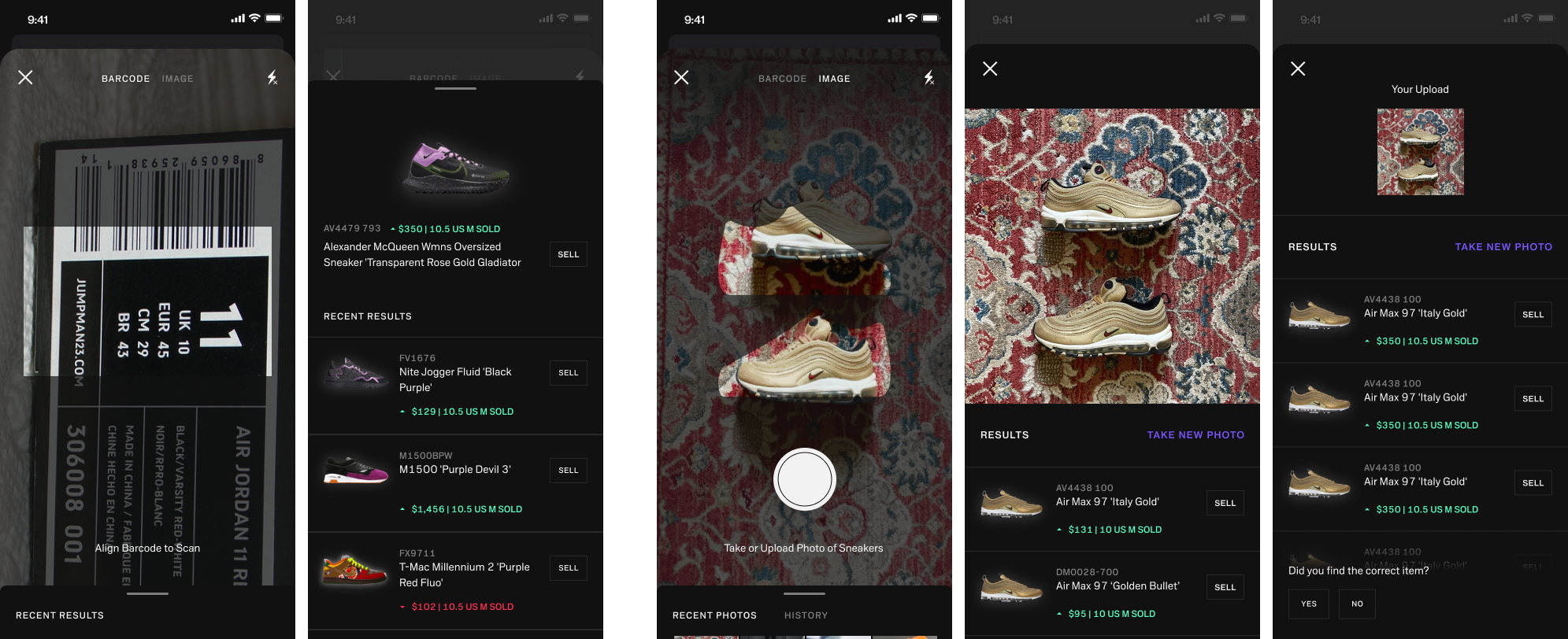ML Search Tool
Company
Alias, a selling platform within the GOAT Group e-commerce ecosystem.
Project Details
Launched and refined a sneaker listing tool to improve discovery, scanning, and listing success across multiple iterations.
Timeline
Phase 1: Jun 2021 - Dec 2021
Phase 2: Aug 2023 - Mar 2024
Role
Product Designer
Problem + Context
Problem
Business Problem
Post-COVID, leadership wanted to differentiate the app and modernize the sneaker selling experience. Sellers were limited to text search, requiring prior knowledge of items and reducing discovery.
Goal
Support sneaker and apparel discovery with ML-powered search
Modernize the selling experience
Differentiate the app in a competitive resale market
Solution
Phase 1: MVP with photo search to validate seller value
Phase 2: Design system updates and usage insights (barcode scanner emphasis) to improve scanning success and seller adoption
Impact
Phase 1: MVP widely adopted; app rating increased from ~4.0 → 4.4
Phase 2: Visual Search now accounts for 13% of searches (up from 5%); UPC scanning ~90% success, image search ~60%
Phase 1: Process
Data Science Collab
Worked with the data science team to determine the optimal number of guesses for sellers → top 4 predictions
Field Research
In-store observations; tested photos at various angles and lighting to validate model performance
Competitive Analysis
Reviewed AR/photo recognition features to inspire and inform interaction patterns
Early Exploration
Photo capture + upload became primary methods; decided image URL could be optional
Placed image alongside results for easy comparison
Used current sneaker templates for ML model accuracy
Initial exploration showing image next to results for easy comparison, leveraging sneaker templates for model accuracy.Iteration & Scope Expansion
Assessed ML constraints and proposed adding barcode scanning to improve accuracy, expanding the project scope.
Addressed technical limitations: since the system could only recognize shoe images, proposed a tab layout and instructional copy to guide users on correct input for sneakers vs. apparel.
Recommended a feedback loop, leading to the implementation of a “Rate the App” CTA to gather early user insights.
Refinements based on manager and stakeholder feedback, emphasizing accuracy and usability while addressing multi-product complexities.Refinement
Adapted to leadership feedback by leading a simpler, focused approach using dynamic copy and interaction design to guide users toward correct behavior.
Balanced usability and technical constraints by educating users to use UPCs or photos solely for sneakers, maximizing accuracy and ensuring a reliable experience.
Focused the design on high-confidence flows, preventing confusion and enabling clear user guidance without introducing unsupported apparel functionality.
Final refinements to streamline user flow, clarify input guidance, and prepare for launch.MVP Visual Search experience — seamless photo and barcode input with dynamic results and seller feedback loop.Takeaways
Outcomes + Results
QA with engineering ensured accurate implementation
Beta field testing validated happy/unhappy paths
Optional photo harvesting step added to continue training MLM, gaining adoption
Sellers widely adopted MVP; app rating rose 4.0 → 4.4
Reflections
Although officially a junior, I stepped into mid-level responsibilities, defining scope, navigating constraints, and influencing cross-functional decisions, building confidence for senior-level ownership.
Lets transition to Phase 2…
As a recently promoted mid-level designer, I took greater ownership and partnered closely with the PM. Together, we re-examined seller needs and emphasized barcode scanning for sneakers while maintaining photo capture/upload support.
Phase 2: Process
Seller Survey
80% rated Visual Search 4/5–5/5
Secondary use: 24% for price-checking
Main pain point: inaccurate scans
Competitive Research
StockX: validated sneaker photo search standards
Yuka: inspired engaging scan interactions (haptic feedback)
Early Exploration
Structure: barcode scan tab + photo capture tab + results pageEarly feedback: add scan line animation, simplify toggle and background gradientIteration
Shifted to barcode-first approach to improve accuracy and streamline user input.
Simplified toggle and refined results sheet to create a consistent experience across barcode and image searches.
Incorporated design director UI feedback: adjusting sizing info, improving image spacing, and standardizing CTAs for clarity.
Final Design
Execution & Collaboration
Briefed Brand team to create a motion asset highlighting sneakers and UPC scanning.
Collaborated with Copy team through annotated Figma briefs to ensure messaging clarity.
Aligned with Engineering and QA, presenting prototypes to support smooth development and address edge cases.
Overall Takeaways
Outcomes + Results
Managed design QA with PM; tracked engineering implementation
Impact Metrics:
Visual Search = 13% of alias searches (up from 5%)
UPC scan success ~90%; image search ~60%
Reflections
Phase 2 allowed me to take full ownership of the design, balancing user needs, technical constraints, and brand alignment. Driving measurable adoption while delivering a polished, consistent experience reinforced my ability to lead end-to-end product design and collaborate across teams effectively.











